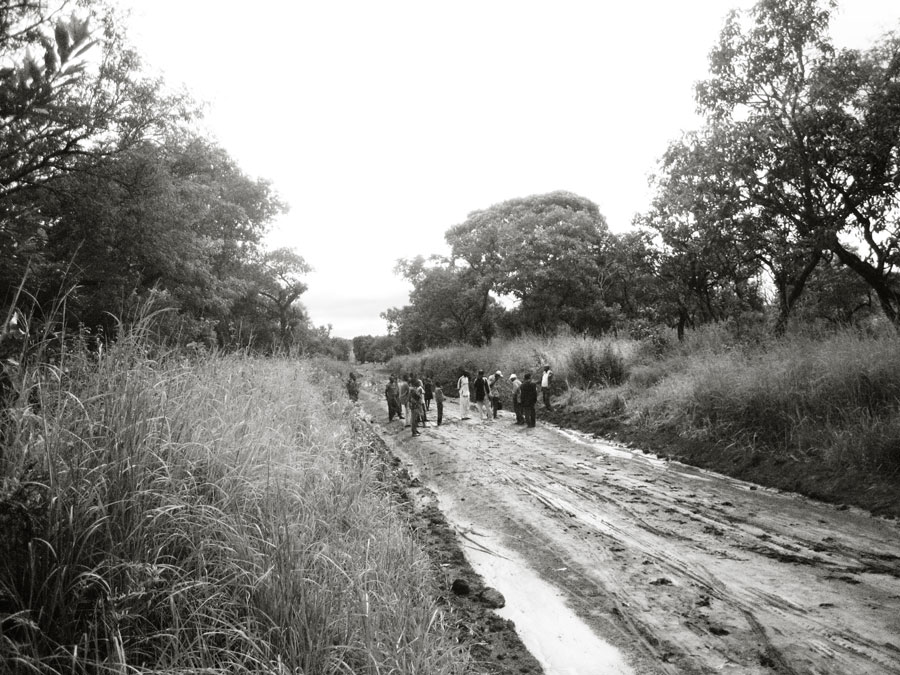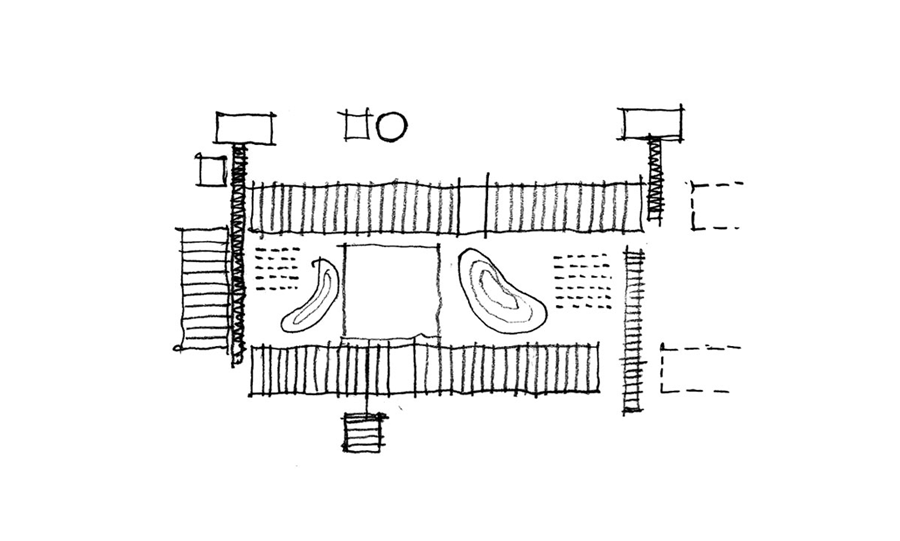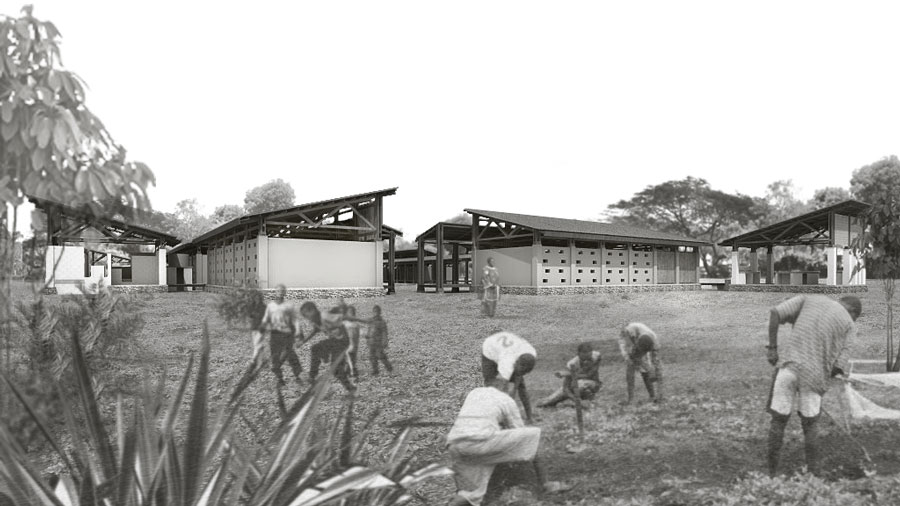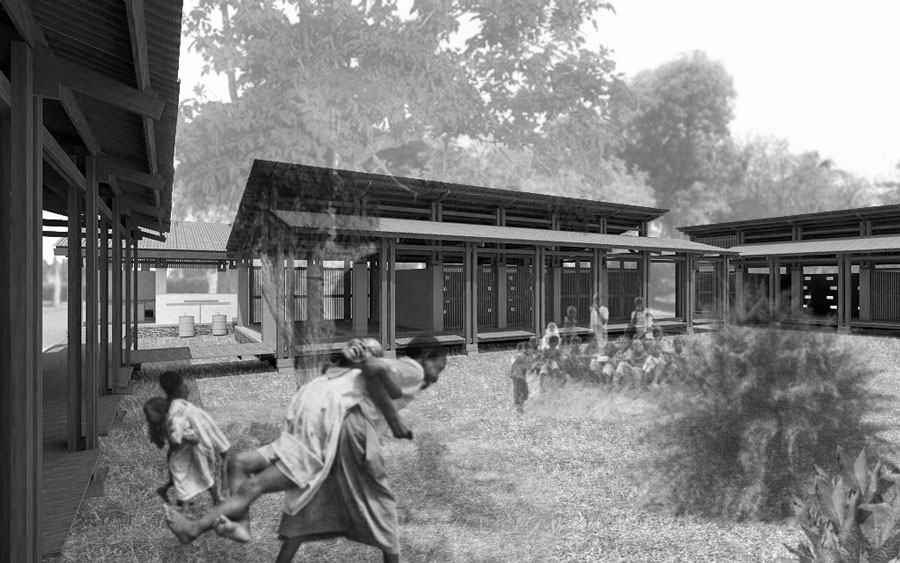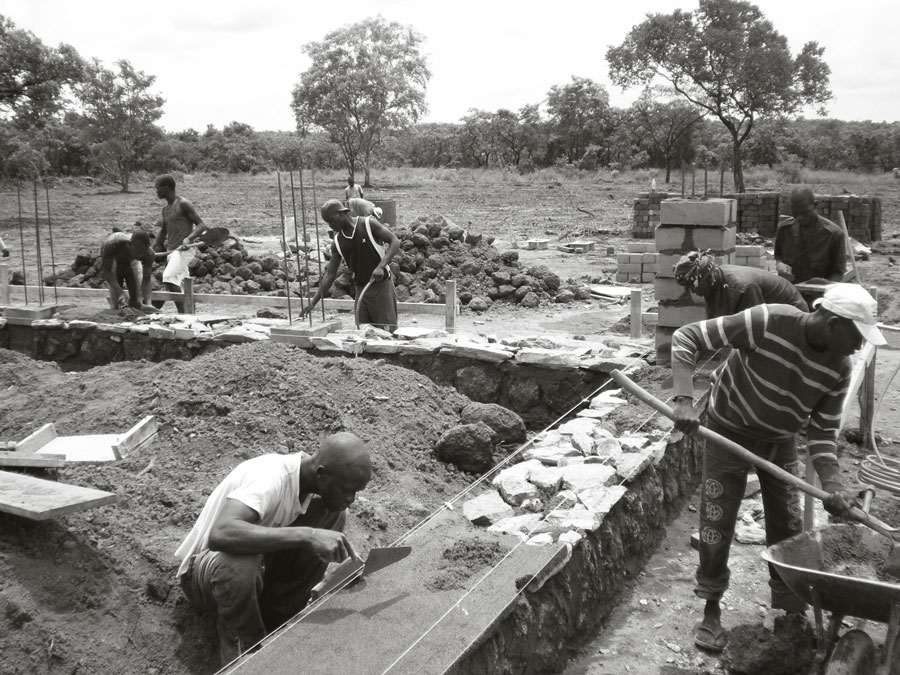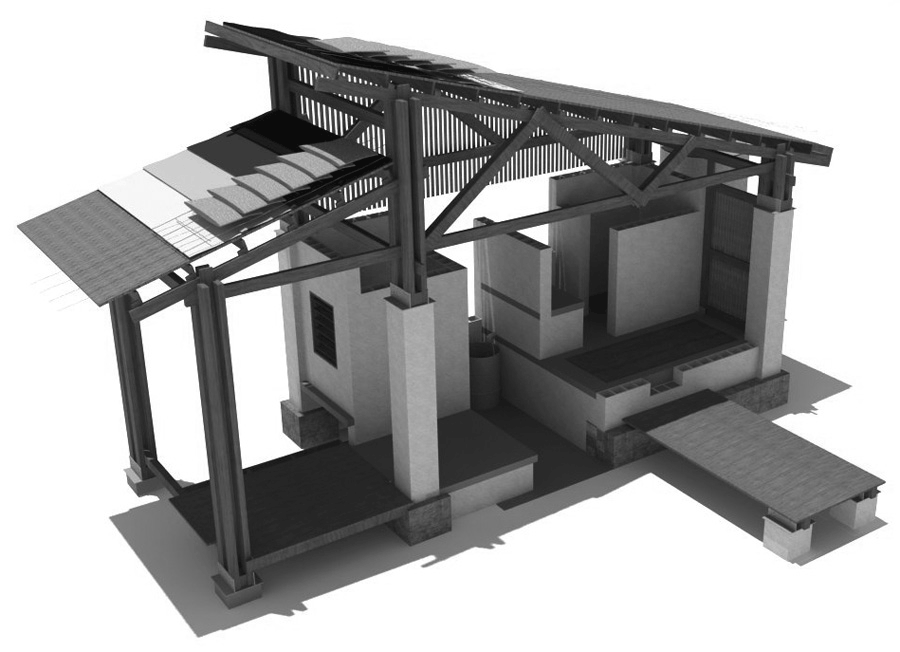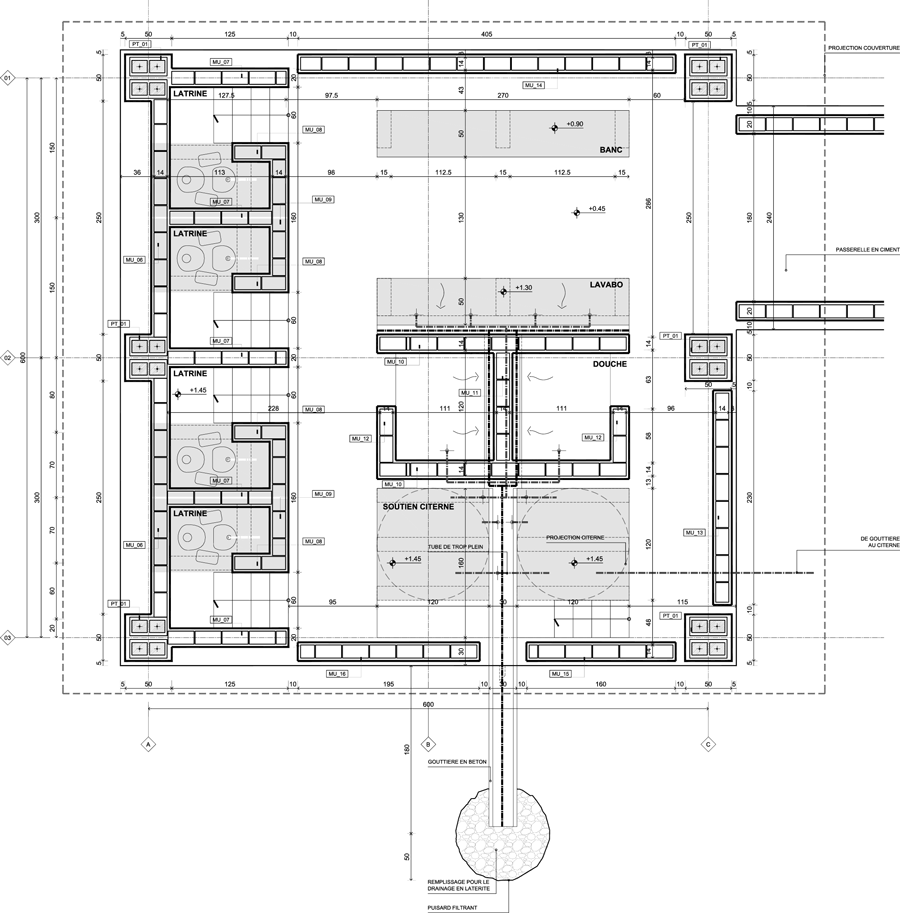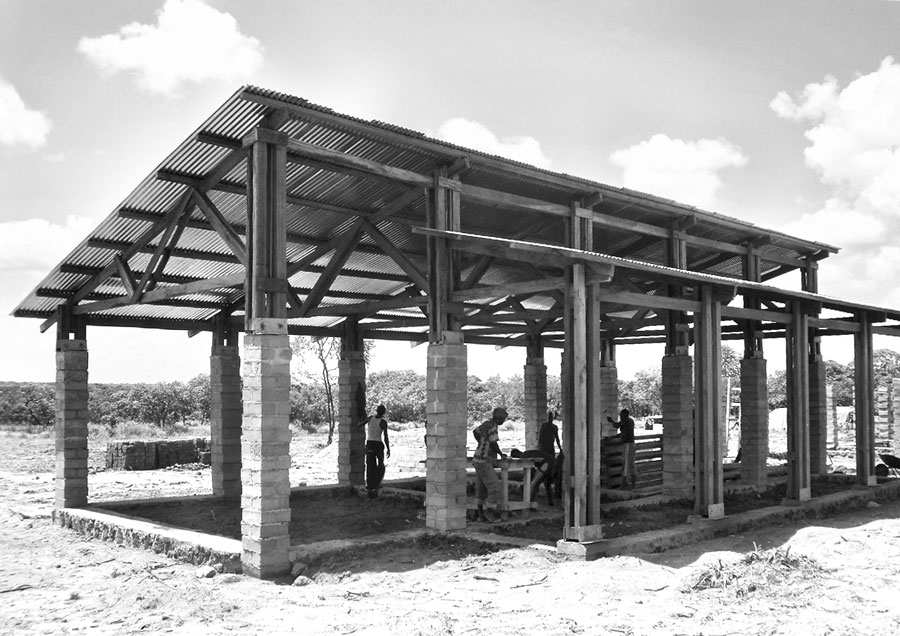FRC > The fight for building
Training Centre_Sassara_Central African Republic [2012-2013]
project details
Date: 2012-2013
Location: Sassara_CentralAfricanRepublic
Description: Students compound including various buildings [dormitories, administration, classrooms] connected by a continuous walkway, with a specific attention for sanitation and appropriate technology
Client: FAO_Food and Agriculture Organization of the United Nations
Final User: JPN_JeunessePionnièreNationale
Type of Engagement: Direct appointment
Role: Consultant-Designer in charge
Services: Concept design, design development, production information, tender documentation, prototypes construction quality control
Status: [06/2014]: Partially built [construction stopped for civil war outbreak]
Sassara
The site [350 km north of Bangui, Central African Republic] is very remote and conditions for production are extreme. During the rainy season many of the roads are extremelly deteriorated thus making transportation potentially hazardous.
The project refers to a training center for the rehabilitation and social reintegration, through agricultural and pastoral activities, of children and teenagers with problematic, social and cultural backgrounds in a post conflict rural area.
The complex is part of a network of similar centres in the rest of the country and is reminescent of an experience that has taken place in some countries of the former French Equatorial Africa and West French Africa, where a constellation of centres aimed at young people training were set up before and after independency.
key numbers
192
youths in the minimal version
288
youths in the maximal version
relevant issues
The sense and meaning of the project relies in the complexity of its evolution, and to a certain extent in the documentation of its imperfect, problematical and partial realization.
It is an effective example, and collection, of the ambiguities and structural constraints affecting the international cooperation, at least as far as construction and related activities are concerned:
- Innovation is far from welcome by all those involved in the process; this applies to local beneficiaries but also to the system as a whole
- This has to do with the inherent inflexibility of the building industry but also with the rigidity of international organizations and their bureaucratic approach
- Consistency between procurement and design is essential for the success of all projects and this applies to cooperation as well: the principle to act on the ‘market’ doesn’t necessarily imply that transparency, accountability and value for money are achieved
- In very remote areas and unstable environment all the negative factors normally affecting the interaction between management and production, control and appropriateness turn out as exacerbated
Download complete project data
project images
Despite the tendency of similar centres for segregation and fragmentation of single functional areas, the project puts a strong emphasis on the idea and experience of institution as a matter of shared entity.
The system should create a place that facilitates interaction while respecting required distinction [segregation] between boys and girls, and between staff and teens: for this reason the whole is organized to form a courtyard.
As a consequence, in terms of general arrangement the complex is therefore formed by separate pavilions, organized so to form a unique entity; a continuous passage facing the courtyard connects all the buildings.
The resulting shape is an elongated ‘U’ with a central courtyard. One end of the courtyard is open for future extension and for direct connection with the landscape, while the other is reserved to common facilities
The aim is to provide schooling and training while giving students housing facilities which enable them to stay in such conditions as not to have to travel back and forth from home town/village.
The training is composed overall of 9 months [3 months of civic training + 6 months of professional training] with the consequent turnover.
The project should be integrated into a social program where various activities are combined, from education to entertainment. The life of the young guests is usually affected by emotional and physical trauma and as such would deserve specific treatment. Some of them have possibly been involved in the past political disorders as child soldiers.
Gender segregation is a specific, additional issue to be taken into consideration.
Given the nature of the community and the local culture [not necessarily related only to religious background], it is common that boys and girls do not share the same spaces at the same time, and in general they are required to be strictly separated.
Particular combination of vulnerability and violence is typically associated to large congregation of teens.
Girls namely are supposed to be in a way removed from direct access.
Due to hierarchical or practical considerations, those conditions are apparently relevant and unquestionable.
The physical implications of them are very hard to be properly outlined since some concern is also related to isolation that comes as a consequence of the required distance.
The limits of available skills, combined with the attitude to go for conventional practice, define the scenario where introduction of [relative] innovation takes place.
The challenge is to find a balance between experiment and feasibility so that lack of competence and tools’ limited availability are not obstacles but conditions to confront and defy.
The strategy for capacity building is thus based on investment on a few, selected components where [relative] complexity can be easily absorbed and diffused.
Nature of design plays a relevant role in fostering technical advancement but it must be closely related to the circumstances of production, including the possibility to test and discuss the proposed solutions.
Nearly the whole complex is realized by standardizing a limited number of components in order to facilitate production and erection.
The project is entirely made with locally identifiable materials and technologies easy and quick to assemble. The materials used include: cement and sand, concrete, laterite stones, hollow concrete blocks, wood, film polyane, metal sheet, straws and standard metal profiles and plaques.
A
mock up has been proposed before work commencement; not a part of the real building but a collection of various components in order to test as many situations as possible that would have been used.
Aims can be summarized as such:
- verify the design assumptions
- optimize, both in terms of buildability and cost, the production
- test technical solutions
The mock up has never been finalized due to bureaucratic constraints.
As far as WASH [water, sanitation and hygiene] a specific solution has been designed. Hand washing facilities and showers are supplied with water collected by rainwater harvesting during rainy season and to be filled manually during dry season. Resulting grey water is then collected for the latrine, stored in drums.
Proposed latrine system is pour-flush latrine with urine diversion.
Treatment is by a twin pit system, which allows on-site treatment and transformation of faecal sludge into a hygienised soil amendment. Urine-diversion dehydration toilets divert all liquids that can be used as fertilizer.
The principle is to use water in the most efficient way, and to intend the personal hygiene as an educational process.
Funds and resources availability, political unstability, cultural distance are regarded as major constraints for the displacement of international cooperation.
All unquestionable, but these are the very circumstances that in principle justify intervention and should be considered as part of the story.
There is a further factor that negatively affects the effectiveness of action, and the project has dramatically suffered from it: the complexity of procurement process, where the [understandable] preoccupation with transparency, fairness, accountability results in a bulk of bureaucratic obligations substantially inconsistent with the local reality. As a consequence the management of procurement, from tender award to contract administration, as turned out as a continuous source of problems, far more critical than ‘technical’ issues.
The complex’s realization, started in July 2012, is currently blocked due to the political situation of the country.
